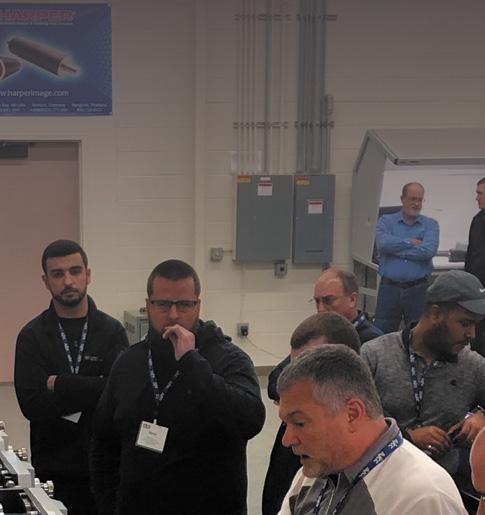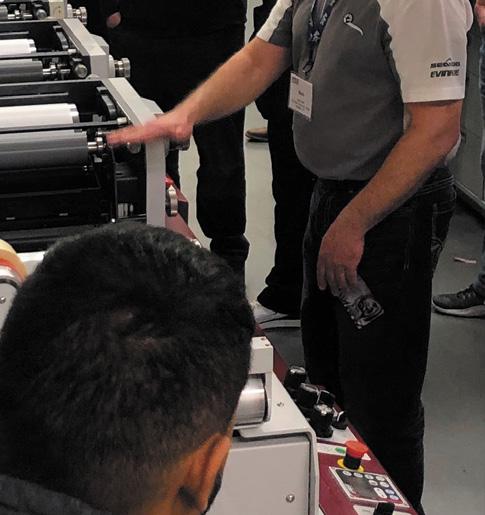
9 minute read
LEADERSHIP
When asked about a typical day in membership services, Moore says, “My role is all about serving our members! AICC lives by the motto, ‘When you invest and engage, AICC will deliver success,’ and my role is to make ‘engaging’ with AICC as easy and as pain-free as possible.”
To say this team is busy is an understatement, but Humphrey and Moore are always ready to help existing and future members fi nd their passion in AICC.
Advertisement
When asked about some of AICC’s key member benefi ts, Moore speaks to the wide range of resources and welcoming community that membership opens the doors to: “AICC is a resource because we off er many products and services that you can lean on in order to benefi t your business (e.g., education, workforce development, industry information, exposure, and health care). AICC is a community because we bring together the industry in meaningful ways and off er you the opportunity to fi nd your place. Th e ‘resource’ idea and ‘community’ idea often work together as well—seminars, webinars, summits, and advisory groups all help create the community aspect.”
As far as education goes, AICC provides many opportunities for growth and learning alongside fellow members through seminars, summits, and national meetings. Th ese events give members from diff erent companies the chance to broaden their skills and network with other industry experts. Humphrey notes, however, that registration fees, travel costs, and time away from work for these in-person events can be barriers. “While the value of live training is exceptional, it isn’t always possible,” she says.
To balance the equation, AICC gives all team members a way to increase their knowledge and skills through free online education. Th ey partner with Th e Packaging School to allow member companies and all respective employees the value-add of training programs for free (in case you didn’t catch that the fi rst time). And with more than 80 online courses in both English and Spanish, all related to the packaging industry and the manufacturing environment, there’s something for everyone.
Overall, Humphrey’s simple yet resounding advice is to get involved. “Th ere are so many resources included with membership—free white papers, BoxScore magazine, access to the AICC experts, and free online education—that can help employees at member companies thrive,” she says. “Th en to really get to know others, build connections and a strong network, the in-person events and peer groups come into play. But all of this means nothing if people don’t get involved and engage.”
Whether you’ve already jumped into your New Year’s resolution or you’re taking the plunge now, AICC and its membership team are ready for you. Contact Humphrey at vhumphrey@aiccbox.org and Moore at pmoore@aiccbox.org to see how they can assist in your current or future membership with AICC.
Julie Rice Suggs, Ph.D., is academic director at Th e Packaging School. She can be reached at 330-7748542 or julie@ packagingschool.com.
Alli Keigley, who contributed to this article, is production coordinator at Th e Packaging School. She can be reached at alli@ packagingschool.com.
Do You Support Industy Education & Growth?

Support the Foundation for Packaging Education.
www.PackagingEd.org/Donate





A Productive Stance
BY SCOTT ELLIS, ED.D.
Your Suppliers
Materials
Info
Tooling Inputs Your Process
What is needed, when and where it is needed
Wonder Widget III Your Customers
Warehouse/Shipping
End User
Next Process
Feedback & Requirements Feedback & Requirements
We are all suppliers of goods, information, or services. In another moment, we are customers. From the end user, the purchaser, the sales contact, customer service, design, prepress, and manufacturing, to shipping, we are a chain of suppliers and customers. Within our company walls, our roles can change by the minute. As a machine operator, I am a customer of all prior processes, and their speed and accuracy will allow me to be a good supplier, producing a quality product on time to keep the promises they have made. So, most of us fill the role of customer and supplier at different points of the day. A key to effective communication is remembering your role in the moment and acting responsibly.
In day-to-day experience, the tyranny of the urgent often blurs what should happen in the service of what needs to happen right now. In these times, we face problems with a fighting stance ready to argue for the priority of a particular job, defending our position, and even seeing those who complain or disagree as a part of the problem.
Consider the construction of a date of delivery. How many fudge factors were really added by the purchaser, the salesperson, or the CSR? And why did they game the system? Most often, the answer is that they were trying to avoid disappointing someone. But what would happen if they just told each other the truth?
The supply chain has been completely disrupted, and no one is happy. In blurry memory of bygone pre-pandemic times, we experienced isolated interruptions to the supply chain. When delinquent materials or tooling caused a delivery promise to be broken, we had choices. We either assigned blame to those people, whoever they might be, or we took responsibility with weeping and gnashing of teeth while vowing that it would never happen again. Under current conditions, we are tempted to throw up our hands and say, “Yep, it’s gonna be late, and oh by the way, so will your order for next week.”
I will not propose a one-size-fits-all solution or pretend that any order is easy today. However, I will point out the futility of waiting for things to calm down before taking time to focus on improving the process. While we cannot fix the world supply chain, we can address the parts of the problem that we do influence. Toward that end, I will propose an alternate strategy to the fighting stance: a productive stance.
To employ the productive stance, new habits must be formed. To get us out of the old habit, it might be helpful to invite members of the daily production meeting to come early. Over coffee, we could discuss and commend our fierce loyalties while agreeing to beta-test the productive stance. If we give it 30 days, we can always go back. Even if the team refuses to try a new method, an individual can choose the productive stance and influence change.

Th ree aspects of a productive stance are: (1) remember who you work for; (2) tell the truth; and (3) face the problem.


Remember Who You Work For
Folks in sales and customer service spend a great deal of time and energy trying not to disappoint a customer. Th e inherent problem is that a CSR may be confl icted trying not to disappoint the end user, the salesperson, or the production scheduler. Under normal circumstances, this has a very low payoff ; now, it is impossible. Th is is often a silent struggle in which we comply with the spoken rule to promise dates that are based on machine backlogs, until we come up against an unspoken rule such as to prioritize the jobs sold by the person whose name is on the building. It is OK to speak openly about this confl ict, asking for guidelines to aid decision-making. Given the example above, many owners enjoy the benefi ts of priority without noticing. If asked to clarify the decision-making strategy, most would provide guidance based on customer importance and what is best for the company. It may be uncomfortable to speak openly about the issues, whatever they may be in your case, but it will result in greater clarity. If you are not working for the productivity of the team, the entire string of internal customers, then you will continually fi nd yourself in fi ghting stance.





Tell the Truth
No matter the past practice required to prioritize the jobs you expedite, make an announcement: “Henceforth, and for at least 30 days, I will not exaggerate the urgency of a job. Rather than shave a day off the actual lead time required by the customer, I will tell you when the job needs to be at the customer’s dock. I will redouble my eff orts to negotiate the date it is needed and try to reduce their fudge factor as well. Th at is my plan, and I hope you will join me, but either way, it is what I am doing.”
Face the Problem
Th e productive stance requires that we stop seeing other customer priorities (internal or external) as the problem. For example, envisioning the upset scheduler as being on the other side of the problem assumes that he or she has a confl icting goal. Th e key to problem-solving is to fi rst defi ne the problem and then get everyone attempting to face it together. If the salesperson and scheduler take a moment to gain perspective, they can agree on a common goal (i.e., to please as many of the right customers as possible). Th en, they can defi ne the current problem, which might be, “We have three important customers who have been promised delivery of large and complex jobs on Friday, and we have neither the machine capacity nor the staffi ng to please all three.”
Th ough you have taken a productive stance, the problem has not been simplifi ed; someone—perhaps everyone— is going to be disappointed. Th e diff erence is that now both people are on the same side of the problem, using the facts as they understand them (truth) and working for a solution that will serve the productivity of the company. Th is will allow a fi ghting chance to please more customers and raise productivity in the long term.




Scott Ellis, Ed.D.,
delivers training, coaching, and resources that develop the ability to eliminate obstacles and sustain more eff ective and profi table results. He recently published Dammit: Learning Judgment Th rough Experience. His books and process improvement resources are available at workingwell.bz. AICC members enjoy a 20% discount with code AICC21.

The Measure of Quality.
PRECISION GLUE SETS











